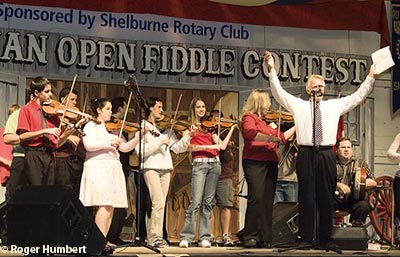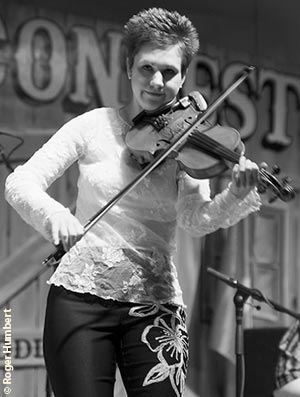 |
The 54th Annual Canadian Open Old Time Fiddle Championship
August 2004 • Shelburne Ontario
|
|
|
| The Contest |
It’s Saturday night in Shelburne, Ontario at the local arena. But there is no hockey game tonight. No, on the second weekend of August every year, Shelburne becomes Fiddleville and people converge at the arena to witness a competition of quite another type, to see who will win the Canadian Open Old Time Fiddle Championship. They will soon be settled in their seats, pen in hand, listening and marking x’s on their programs beside their picks.
|
|
 |
|
These days there are many fiddle contests around but this is still 'the' contest to win in the Old Time Fiddling world. This competition requires real chops. And there is more to this contest than the Championship class. Other categories are the Duet class, 9 years and under, 12 and under, 18 and under, 19 to 45, 65 and over and the novelty class.
Originally held to raise money for local charities, the event still serves the same purpose but has expanded it’s scope. This year the money will help support minor hockey and local charities but funds will also be used in an effort to eradicate polio worldwide.
In it’s first year all of the contestants were from Ontario. The second year saw the first American entrants. Sleepy Marlin from Louisville, Kentucky won the championship in 1954. In 1955 Jean Carignan was the first fiddler from Quebec to enter. Maritimer Ned Landry won in 1956, 1957 and again in 1962. Many years have seen contestants from almost every province and territory as well as American fiddlers from different states. This year a young woman from Russia, Albina Molodojan, took fourth place in the 19 to 45 class and Lauren Brunswick of Boston, Massachussets won first prize in the same class.
|
 Shane Cook, Mark Sullivan and Louis Schryer
Shane Cook, Mark Sullivan and Louis Schryer
|
This year’s Championship class winner was Mark Sullivan of Bowmanville, Ontario. The second place prize went to Shane Cook of Dorchester, Ontario. Mark and Shane have been trading first and second place for 4 years now. The third place winner was Louis Schryer of Chapeau, Quebec. Louis is well known to fans and has won first place seven times. He has also been a judge at the contest. This was the first year of the people’s choice award given in honour of the late Merv Woods. Over 400 people cast their ballots at Friday night’s playdowns for the winner who was announced Saturday night. The recipient of the award was Scott Woods, Merv’s son. He also placed sixth in the Championship class on Saturday night.
How is the champion chosen? The rules are simple enough. Each contestant has to play a waltz in 3/4 time, a jig (6/8 time) and a hoedown or reel (2/4 or 4/4 time), in that order in four minutes or less. Styles and technique have evolved and today’s champions have years of experience and musical training behind them but Old Time fiddling was and is, first and foremost, dance music. Number 1 on the list of criteria are time and tempo. Next on the list is tone and then style, technique and overall accuracy. The tunes have to be accepted old time standards. "Playdowns" are held Friday afternoon and Friday night to select the finalists who play Saturday night.
The Saturday night program includes other entertainment. There may be a comedian, a singer or other fiddle music such as the Cape Breton Orchestra or Natalie MacMaster. Often, those on stage are past participants and former winners - people like Frank Leahy, Oliver Schroer, Calvin Vollrath, Ed Gyurki, Chuck Joyce and Rudy Meeks. Rudy wrote The Fiddles of Shelburne which is always played by a large group of contestants and winners at the close of Saturday night’s show.
April Verch and her band provided the entertainment this year. April is one of Canada’s finest fiddlers and was champion in 1998. Only the second woman to win the contest, she played two tunes written by Eleanor Townsend who was the first.
|
| After almost a year of touring including concerts in Finland and Vermont, you might think that April would be tired, but she radiated such energy and exuberance that the audience spontaneously started clapping to the rhythm. Toes were tapping and heads were bobbing. Her music expresses the sheer joy of being alive as her bow bites into the strings. As if virtuosic fiddle playing were not enough, she is an extraordinary step dancer, beating out rhythms on the stage with complex fleet footwork often while playing. And she sings!
April’s roots are in the Ottawa Valley but she has the ability to play anything she wants including other regional Ontario styles with strong Irish and Scottish roots, French Canadian and Appalachian styles. She also likes Latin rhythms and East European sounds. Ears ever open, she infuses traditional styles with a new vitality and somehow makes them as relevant as they ever were but never by adding heavy rock style accompaniment which so easily annihilates the light and airy gaiety of the fast pieces and the delicacy of the quiet ones.
|
|

April Verch |
|
|
The other members of the band are also excellent musicians — Kyle Kegerreiss on bass, Hans Holzen on guitar and harmonies both from Nashville, Tenessee and Marc Bru on spoons, shakers, bodhran and harmonica. Kyle treated the crowd to a bass solo that never lost its momentum and Marc Bru followed him with a stirring, extended solo on the bodhran (Irish drum) unlike anything I have ever heard. Kyle started his career in jazz and later encountered the music of Alison Kraus, Bill Frisell, Mark O'Connor, and Edgar Meyer which influenced him to move to Nashville and work with roots musicians. Hans Holzen grew up in Nashville surrounded by bluegrass and new acoustic music. He moved away to study jazz at the University of Miami and returned to Nashville with his degree. He now plays a variety of genres. Marc Bru, a Canadian and April’s husband, is North America’s foremost bodhranist.
|
|
|
|
Report by Joyce Corbett • Photographs by Roger Humbert
|
|
|




